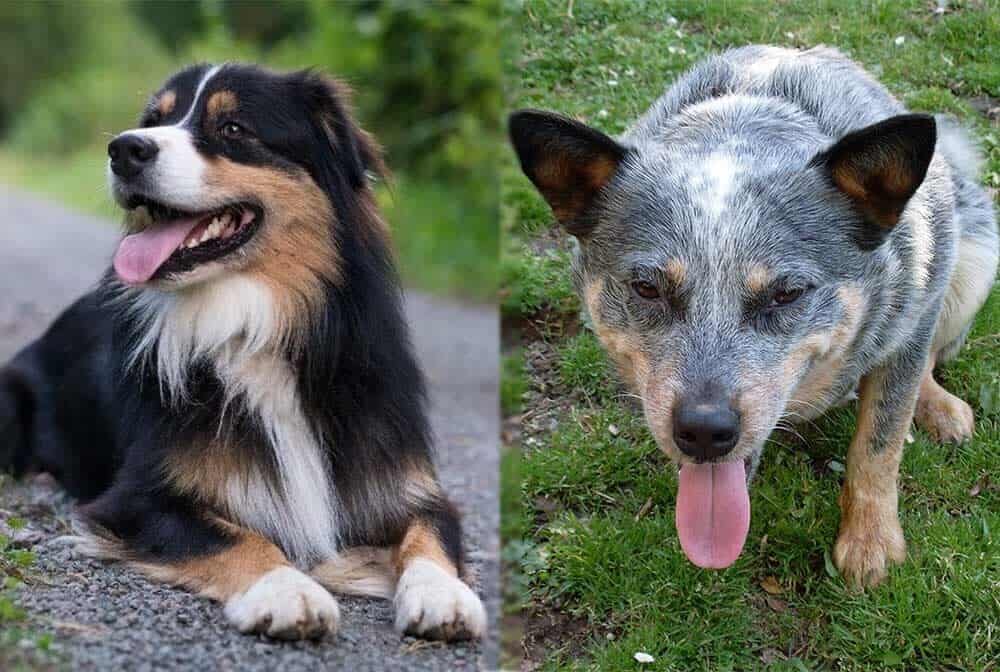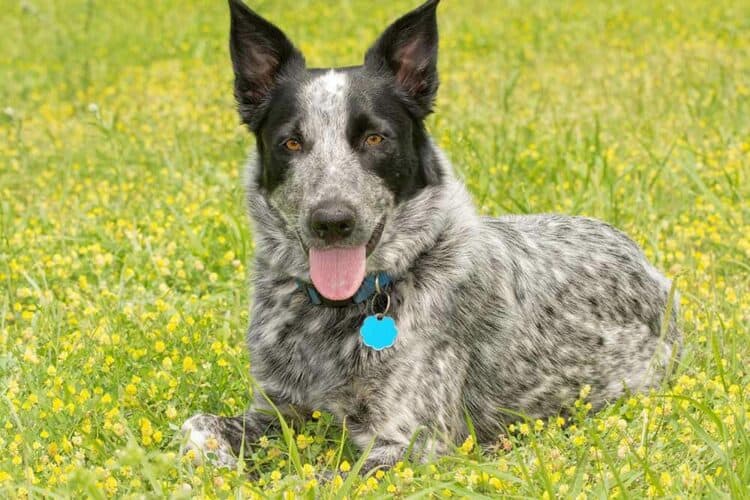| Height: | 17–22 inches |
| Weight: | 25–50 pounds |
| Lifespan: | 12–15 years |
| Colors: | Black, blue, blue merle, fawn, gray, brown, white |
| Suitable for: | Active families with plenty of space and experience with dogs |
| Temperament: | Loyal, active, playful, intelligent, hardworking, affectionate with family |
The result of a Blue Heeler and Australian Shepherd cattle dog mix is the very striking Texas Heeler, which was named after the state the breed originates from. A pastoral breed, Texas Heelers—like both their parent breeds—are known for their high intelligence, herding abilities, and strong work ethic.
Though not officially recognized as a breed in its own right, the Texas Heeler is nevertheless a popular family dog that can still be found keeping order on farms and ranches around the US. In this post, we’ll share all there is to know about this very distinctive hybrid.
Texas Heeler Puppies – Before You Buy…
https://www.instagram.com/p/Cg1oapyuq3H/
The 3 Little-Known Facts About Texas Heelers

1. Texas Heelers are a Bobtail Breed
Texas Heeler puppies are usually born with bobbed tails, though some are not. This trait causes some to mistakenly think that Texas Heelers’ tails are docked.
2. They Were Bred in the 1970s
Though we don’t have an exact date, we do know that the 1970s mark the birth of the first Texas Heelers. They were intentionally bred to blend the best traits of their two parent breeds, which is why Texas Heelers are known as a “designer” breed.
3. They’re Known for Being Shy with Strangers
Though affectionate with family, Texas Heelers are known for being more reserved around strangers, though they’re rarely aggressive. This wariness comes down to their natural alertness and protective streak.
Temperament & Intelligence of the Texas Heeler
Are These Dogs Good for Families? 👪
Texas Heelers make great family dogs. They’re typically affectionate and protective of their families, easy to train, and active and energetic enough to be wonderful companions for children who know how to sensibly and respectfully interact with dogs. Of course, proper socialization with Texas Heelers is key.
They may be best placed in a family with older children, as Texas Heelers are reputed to sometimes try “herding”—albeit non-maliciously—small children. Some may gently nip at little kids’ heels or accidentally knock them over due to their natural herding urges, though not every Texas Heeler will display this behavior with children. Early socialization may help curb it.
As a highly intelligent breed, Texas Heelers can be somewhat strong-willed, so they may not be the best fit for beginner dog parents. They can also become destructive if not mentally or physically stimulated enough or are left alone for too long, so it’s crucial to channel their intelligence and energy by way of lots of exercise and playtime.
If you don’t lead an active lifestyle or you live in an apartment, a Texas Heeler may not be a good fit for you. These dogs have a natural urge to be out working and exploring in open spaces, so they’re best suited to active families with enough space—ideally a secured yard, too—to prevent them from going stir-crazy with boredom. Just bear in mind that they should not live outdoors, nor should any dog.
Families who like outdoor pursuits like hiking and exploring would be perfect for Texas Heelers.
Texas Heelers are also pretty fond of routine, so need lots of consistency from their humans— especially when undergoing training.
Does This Breed Get Along with Other Pets?
With proper socialization, Texas Heelers, like any dog breed, can get along with other pets like dogs and cats. Due to their herding instincts, they have a tendency to be a little bossy and may nip at your other pets’ heels in an attempt to “herd” them. Early socialization can help your Texas Heeler to understand that your other pets aren’t there to be herded!
https://www.instagram.com/p/CD6lE33pkaP/
Things to Know When Owning a Texas Heeler
Food & Diet Requirements 🦴
Texas heelers require high-quality dog food to help keep them as active and healthy as possible. Above all, dogs require protein from meat sources, but also a variety of fruits, vegetables, and grains, which can deliver the essential vitamins and minerals they need to thrive. Buying from a high-quality, trustworthy commercial brand is the easiest way to make sure your Texas Heeler is getting all of this good stuff.
You might want to consider dog foods formulated for medium-sized and/or active dogs, as Texas Heelers are such an energetic breed. Active dog formulas are typically designed to help support lean muscle development and optimize their energy.
Exercise 🐕
Well…where do we start? By this point, you’ll no doubt have it down-packed that Texas Heelers repel lounging around the house like the plague! These dogs need to be exercised daily, whether that’s leash-walking, hiking, or running, to prevent boredom and destructive behavior.
We can’t imagine anything that would make a Texas Heeler happier than running after a ball or trotting happily alongside their human on a countryside trek. When not out and about, exploring your Texas Heeler will still require plenty of space at home—preferably a secure yard to investigate.
https://www.instagram.com/p/CVJJfRtpBZ0/
Training 🎾
Texas Heelers are super smart and thrive off the learning process involved in training. For one thing, it allows them to spend time with their favorite humans, and for another, it involves physical activity—a Texas Heeler’s favorite pastime!
Their high intelligence makes them easy to train, and it’s unlikely that you’ll face any serious issues teaching a Texas Heeler how to walk on a leash and follow commands. Texas Heelers are very eager to please, which means you’re likely in for a very smooth ride in the training department.
Just remember that these dogs can be a bit strong-willed, so they need kind but firm leadership to learn boundaries. If paired with a weak-willed or too-passive human, the Texas Heeler will be running the show in no time.
Never resort to physical punishment in training, though, as this will severely damage your dog’s bond with you, and, of course, is just plain cruel. Instead, use a firm tone of voice when necessary and stay calm and patient at all times. Praise and reward your Texas Heeler when they do something well.
Grooming ✂️
Texas Heelers have a short double coat and are considered moderate shedders. A good brushing every few days should be just enough for Texas Heelers. As Texas Heelers are often out and about stretching their legs, it’s especially important to make sure their claws are in good condition and trimmed regularly to avoid painful ingrown nails and general discomfort.
You’ll have to anticipate a fair few baths, too, given that Texas Heelers like to spend time outdoors. A cleanup operation is likely to be required from time to time, so be sure to equip yourself with some dog shampoo.
https://www.instagram.com/p/CfVXeOqNF2d/
Health and Conditions 🏥
Texas Heelers have long lifespans if properly cared for and are considered a generally healthy breed overall, but unfortunately, no dog gets a free pass when it comes to being prone to certain health conditions. Texas Heelers have been linked to elbow and hip dysplasia, overheating, foot and leg injuries, and eye problems.
Other conditions that could potentially affect Texas Heelers include obesity, cancer, epilepsy, and deafness. These conditions have been linked to the parent breeds, Australian Shepherds and Blue Heelers.
- Mild eye conditions
- Minor foot and leg injuries
- Overheating
- Elbow and hip dysplasia
- Obesity
- Cancer
- Deafness
- Epilepsy
Male vs Female
There are no known major differences between male and female Texas Heelers apart from females being slightly smaller and lighter than males. Female dogs generally tend to mature faster than male dogs, too, which may make them a little easier to train.
Unneutered male dogs may be more dominant, whereas unspayed females are more prone to mood changes due to fluctuating hormones. Once spayed or neutered, however, these behaviors often improve in both sexes. Other than this, there’s no evidence that gender affects a Texas Heeler’s personality in any way.
Conclusion
If you’re looking for a sprightly and unfailingly loyal pooch to join your family, the Texas Heeler might just be the dog you’re looking for. We highly recommend checking out shelters and adoption centers to find your perfect match, as there are no doubt some very lovely Texas Heelers out there waiting for a loving new home.
Featured Image Credit: Sari ONeal, Shutterstock














